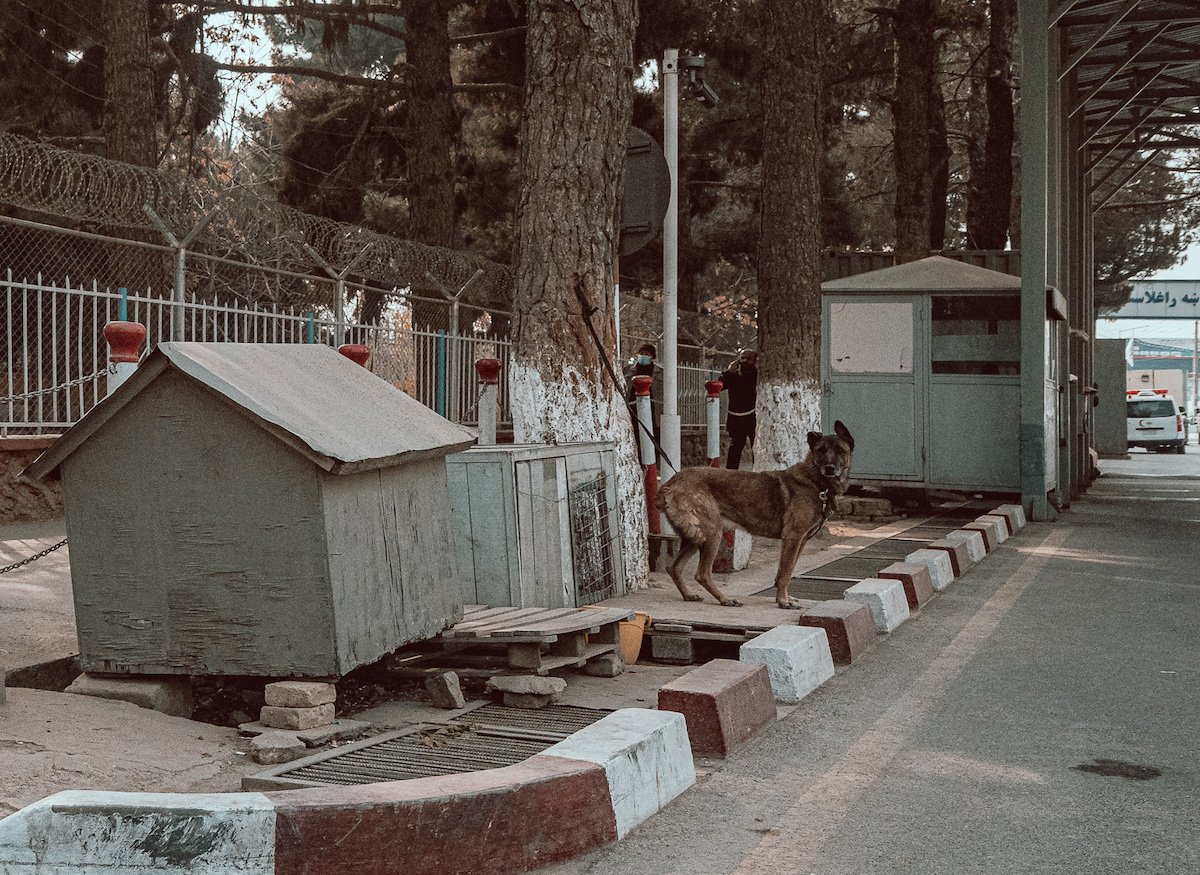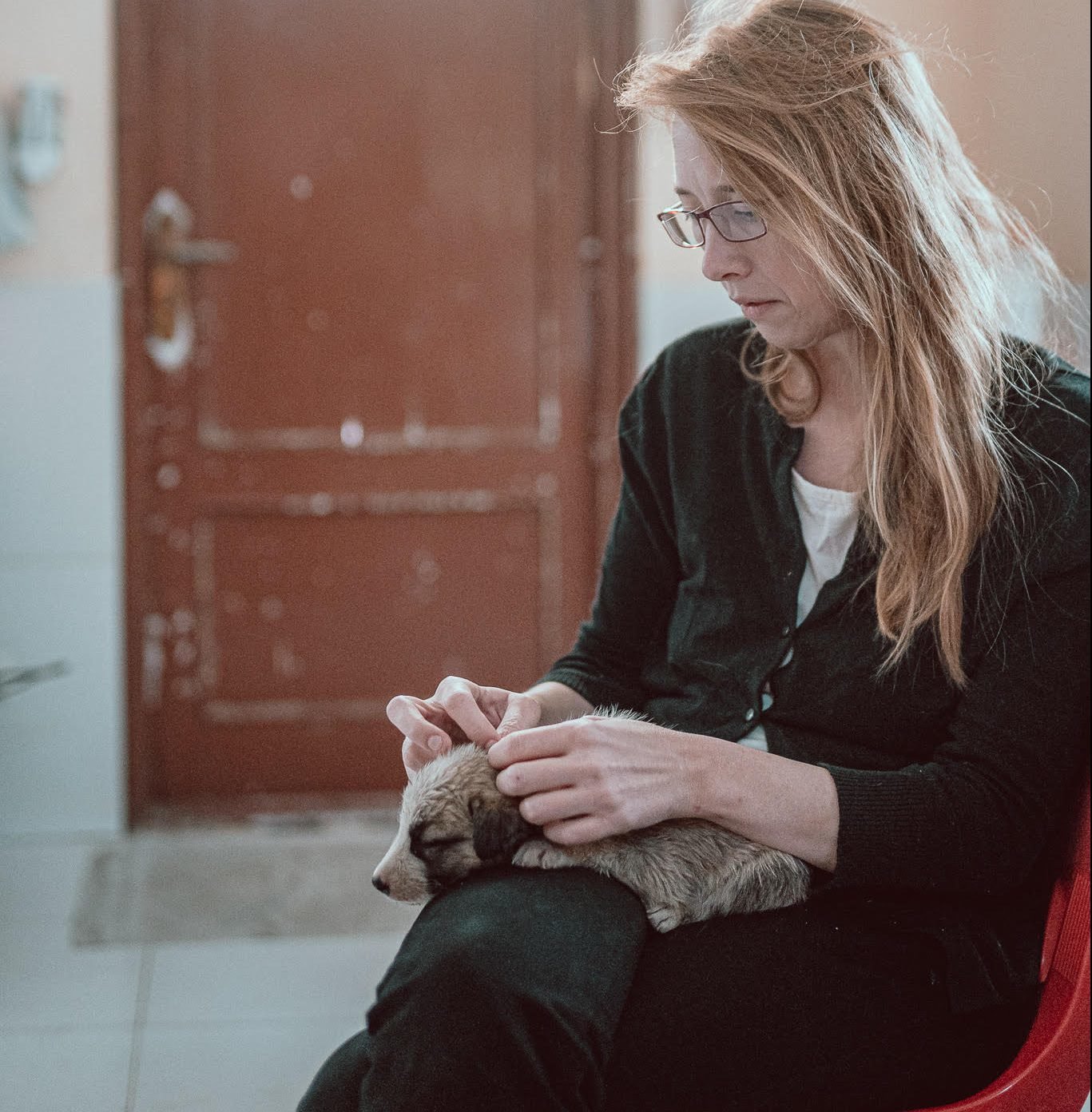The US Left More Than 100 Dogs in Kabul — And Some Are Now in Taliban Hands

In a photo circulated on social media during American exit from Afghanistan, dogs in crates wait in vain for evacuation. Kabul Small Animal Rescue has not given up on bringing the dogs to safety.
KABUL, Afghanistan – Almost three months ago, a social media firestorm erupted after users circulated an image of around 130 dogs in cages amid the frenzied US evacuation from Hamid Karzai International Airport, or HKIA. Rumors spread that the US government was leaving behind working dogs.
The Department of Defense quickly clarified that the canines did not belong to the American military but were privately owned by contractors and had been placed in the care of private nongovernmental organization Kabul Small Animal Rescue.
Charlotte Maxwell-Jones founded Small Animal Rescue in 2018 and, months after the US’ last plane left, continues to operate veterinary and rescue services across embattled Afghanistan. Of the 130 dogs left by the US — most of whom were released from their cages in the final hours of the evacuation — Small Animal Rescue has recovered around 70, she said, and she estimated that 20-30 have died.
The rest are in the hands of the Taliban, Maxwell-Jones said, though it’s unclear how the dogs were being treated or used.
“Now [the Taliban] have taken a bunch of working dogs,” Maxwell-Jones said. “I think they want to use them, but they don’t know how to use them. So they just walk them around.
“They realize that they are a necessity for more organized security than they had before.”

Maxwell-Jones surmised that the attention given to the animals on social media amid the US exit made the Taliban view the dogs as a “bargaining chip” with Western countries that staunchly value animal well-being.
Still, that was not enough to save all the dogs.
“Early on, we got some videos of working dogs getting their noses cut off, which is hideous. But we haven’t seen any of that since,” Maxwell-Jones said. “They shot some of the spaniels. Those are very friendly, so they would have run up and [the Taliban guards] would have been scared.”
The animal activist added that the clinic had located seven of the dogs in the streets after they presumably broke free of the HKIA confinement.
“There is a possibility that [the Taliban] is shuffling some of the dogs around. They recognize German shepherds as working dogs, even though the German shepherds that were there were not working dogs,” she said. “So the Taliban kennels those. There are about 40 of them there.”
On the rare occasions that I saw the dogs, they were sitting miserably on leashes outside government buildings with armed Taliban fighters trying to look tough while clearly having no idea how to orchestrate a sniff detection.

One Taliban intelligence official told me that the Taliban have the dogs “working at the airport,” although it seems the dogs are not trained for specific security roles. Rather, it seems the dogs are there to make Taliban members look tough and well-equipped.
Maxwell-Jones also stressed that some cats that weren’t flown out were experiencing an odd array of respiratory illnesses, likely from the cheap tear gas the Taliban used around HKIA that may have possessed a “mustard component.” Some of the cats died during the evacuation, she said.
The future of animal welfare under Taliban rule remains chillingly uncertain. Moreover, in a nation of nearly 40 million people wrestling with deep financial and security woes, animal health is likely very low on the Taliban’s list of priorities.
During its rule from 1996 to 2001, the Taliban prohibited dogs as pets, viewing them as “unclean.” Under a decree by Taliban founder Mullah Mohammad Omar, the rulers even forbade printing animal pictures on products and photographs of people and animals.

The new regime, officially termed the Islamic Emirate of Afghanistan, has yet to disseminate a formal decree regarding animals in the home. However, local authorities are said to be taking matters into their own hands, mandating that residents cannot keep pets or that pets must be kept outside, even as the harsh winter sets in.
On the flip side, the Taliban in the 1990s outlawed “haram” gambling activities such as dogfighting and bird fighting, which had long attracted the ire of international animal rights activists. Yet these popular pastimes made a comeback in conjunction with the US footprint Afghanistan after 2001, and they survive underground.
For three months now, Kabul Small Animal Rescue has worked to evacuate scores of dogs and cats and slice through the seemingly endless ribbons of red tape.
“We are working on permits,” Maxwell-Jones explained. “It used to be that you went to the Ministry of Agriculture, and they fill out a form. But now [we] have to go through the Taliban, and they don’t have protocols worked out.”

Making the effort more challenging is the fact that, in June, the US Centers for Disease Control and Prevention issued a “Temporary Suspension of Dogs Entering the United States from High-Risk Rabies Countries.” Afghanistan is considered one such country.
“We are going to have to do an initial stop somewhere outside of [Afghanistan], and we are going to have to redo the crates for the dogs, as we have wooden crates,” Maxwell-Jones explained. “The cats are easier. However, the dogs will have to be in Canada for at least six months if they have US owners because of the CDC ban.”
Kabul has long struggled with a stray dog infestation that comes alive after darkness falls. The strays sleep among the mountains of waste and in narrow back alleys during the daytime, and at night they snap, snarl, and bite in their desperate hunt for food. But with many restaurants now shuttered and much of the Afghan human population starving, the ravenous dogs have become all the more demanding in their quest for survival.
Previously, the Public Health Ministry dedicated a prominent portion of its budget to administering rabies vaccines to those attacked. However, it is now unclear whether the money-strapped Taliban — who have not been able to pay their public health professionals’ salaries for months — will maintain the life-saving service.
Read Next:

Hollie McKay is a foreign correspondent, war crimes investigator, and best-selling author. She was an investigative and international affairs/war journalist for Fox News Digital for over 14 years where she focused on warfare, terrorism, and crimes against humanity; in 2021 she founded international geopolitical risk and social responsibility firm McKay Global. Her columns have been featured in publications including the Wall Street Journal and The Spectator Magazine. Her latest book, Only Cry for the Living: Memos From Inside the ISIS Battlefield, is now available.
BRCC and Bad Moon Print Press team up for an exclusive, limited-edition T-shirt design!
BRCC partners with Team Room Design for an exclusive T-shirt release!
Thirty Seconds Out has partnered with BRCC for an exclusive shirt design invoking the God of Winter.
Lucas O'Hara of Grizzly Forge has teamed up with BRCC for a badass, exclusive Shirt Club T-shirt design featuring his most popular knife and tiomahawk.
Coffee or Die sits down with one of the graphic designers behind Black Rifle Coffee's signature look and vibe.
Biden will award the Medal of Honor to a Vietnam War Army helicopter pilot who risked his life to save a reconnaissance team from almost certain death.
Ever wonder how much Jack Mandaville would f*ck sh*t up if he went back in time? The American Revolution didn't even see him coming.
A nearly 200-year-old West Point time capsule that at first appeared to yield little more than dust contains hidden treasure, the US Military Academy said.












